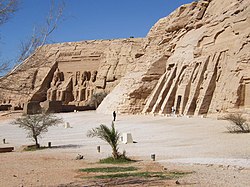
Back Aboe Simbel-tempels Afrikaans أبو سمبل Arabic ابو سمبل ARZ Abu Simbel AST Əbu Simbəl Azerbaijani Әбү Симбел Bashkir Абу-Сімбел Byelorussian Абу Симбел Bulgarian আবু সিমবেল Bengali/Bangla Abu Simbel BS
You can help expand this article with text translated from the corresponding article in German. (April 2023) Click [show] for important translation instructions.
|
 | |
| Location | Aswan Governorate, Egypt |
|---|---|
| Region | Nubia |
| Coordinates | 22°20′13″N 31°37′32″E / 22.33694°N 31.62556°E |
| Type | Temple |
| History | |
| Builder | Ramesses II |
| Founded | Approximately 1264 BC |
| Periods | New Kingdom of Egypt |
| Official name | Nubian Monuments from Abu Simbel to Philae |
| Type | Cultural |
| Criteria | i, iii, vi |
| Designated | 1979 (3rd session) |
| Reference no. | 88 |
| Region | Arab States |
Abu Simbel is a historic site comprising two massive rock-cut temples in the village of Abu Simbel (Arabic: أبو سمبل), Aswan Governorate, Upper Egypt, near the border with Sudan. It is located on the western bank of Lake Nasser, about 230 km (140 mi) southwest of Aswan (about 300 km (190 mi) by road). The twin temples were originally carved out of the mountainside in the 13th century BC, during the 19th Dynasty reign of the Pharaoh Ramesses II. Their huge external rock relief figures of Ramesses II have become iconic. His wife, Nefertari, and children can be seen in smaller figures by his feet. Sculptures inside the Great Temple commemorate Ramesses II's heroic leadership at the Battle of Kadesh.
The complex was relocated in its entirety in 1968 to higher ground to avoid it being submerged by Lake Nasser, the Aswan Dam reservoir. As part of International Campaign to Save the Monuments of Nubia, an artificial hill was made from a domed structure to house the Abu Simbel Temples, under the supervision of a Polish archaeologist, Kazimierz Michałowski, from the Polish Centre of Mediterranean Archaeology University of Warsaw.[1][2]
The Abu Simbel complex, and other relocated temples from Nubian sites such as Philae, Amada, Wadi es-Sebua, are part of the UNESCO World Heritage Site known as the Nubian Monuments.[2]
- ^ "Abu Simbel". pcma.uw.edu.pl. Retrieved 2020-08-05.
- ^ a b Centre, UNESCO World Heritage. "Nubian Monuments from Abu Simbel to Philae". whc.unesco.org. Retrieved 2018-02-24.

